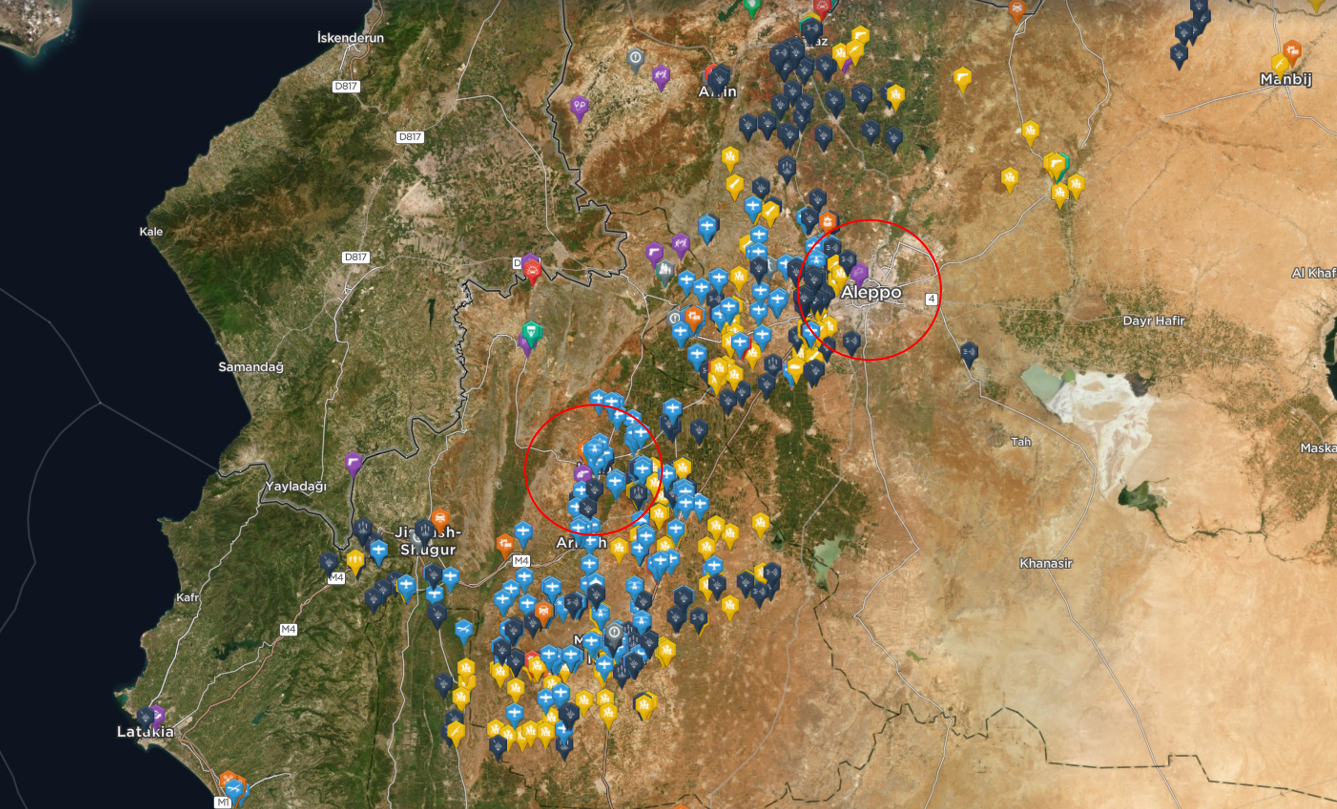COVID-19 in Rebel-Held Northwest Syria
Analysing the impact of COVID-19 in Syria, with a particular focus on the rebel-held cities of Aleppo and Idlib.
Background to the Conflict
Whilst Syria as a state remains whole, internal boundaries are clearly defined between Syrian Democratic Forces (SDF), Syrian Government held territory and territory currently held by Hayat Tahrir al-Sham (HTS), Turkey and Turkey’s local proxy forces.
These boundaries have remained fluid throughout the course of the nine year long Civil War, with government forces gaining the upper hand over rebel forces after the intervention of Russia. Russian aircraft have supported Syrian Government ground offensives, battering rebel held positions and towns in what has become a relatively static conflict.
Over the course of the fighting, Syrian government forces have captured the majority of Syria’s major population centres, including Hama and Aleppo. Fighting currently centres around the M5 Highway, which is a major highway running through rebel territory in Idlib and Aleppo provinces.

Idlib and Aleppo, the focus of this report, are the most violent parts of Syria and have witnessed years of daily airstrikes, artillery fire and fighting between rebel and Syrian Government forces.
Today, after multiple Russian-backed Syrian Government ‘bite and hold’ type offensives, rebel forces control only a small portion of territory when compared to territorial control seen years ago. Approximately 4,000,000 people are believed to live in this small rebel held enclave with much of the area’s population living in refugee camps close to the Turkish border or in poor living conditions. Consequently, not only is the outbreak in this part of Syria expected to be substantial, it is also deemed inevitable.
Response to the Disease
At a national level, the response to the outbreak has been slow and under-powered. The Syrian Government reported its first cases of COVID-19 in late March 2020, weeks after neighbouring countries reported their first cases and had taken precautions.
As of April 6th 2020, only 19 confirmed cases have been recorded in Syria, although it is presumed that high numbers of infections have already taken place, and have either not been reported in media or simply were never diagnosed. The high numbers of foreign personnel, Iranian personnel in particular, in Syria and high levels of cross border travel with neighbouring countries also serves to increase the likelihood of infections. These factors cast further doubt on the claims made by the Syrian Government regarding total infections.
Despite the discourse emanating from the Syrian Government being slow to accept COVID-19 within its borders, actions have been taken by the government such as shutting down universities, schools and government offices. Entry for foreigners into Syria was also banned on March 20th 2020, seemingly acknowledging the threat posed.
Rebel-held Idlib and Aleppo began to acknowledge the outbreak around the same time as the Syrian Government, with the ‘Salvation Government’ of HTS releasing pamphlets and online material stressing the importance of hygiene. Limited sterilisation campaigns have also been carried out in some public spaces. The extent of the sterilisations is not entirely clear, but it’s likely that large numbers of public spaces have not been sterilised at all.
More recently, HTS has also closed major markets and other public gathering places in cities such as Jisr al-Shughur and Darkus although Friday prayers are still reported to be going ahead as of early April in some cases.
The Turkish military itself has also taken precautions at a tactical level, as the movement of soldiers has been restricted (but not stopped) in order to try and limit infections. However, reports of convoys entering Syria from Turkey carrying medical supplies continue to be seen, rendering restrictions on troop movement as largely ineffective. Turkish military medical personnel have also been sent to Syria where they will assist in training related to COVID-19.
Access to Medical Facilities
Not only has the response to COVID-19 in Syria been relatively slow, the ability for the country to respond to the outbreak is severely limited, nowhere more so than in rebel held Idlib and Aleppo. The testing process itself is incredibly slow due to a near total lack of testing machines and kits.
As of late March, there was only one testing machine in Idlib Province, and just 2,000 test kits, equating to about 10 tests per day. Intensive treatment of those that are found to be infected is also weak, with some hospitals reporting that they only have one ventilator. Medical supplies in the quantity required have been slow to reach Idlib but limited supplies have come from the World Health Organisation (WHO) who have already sent 300 test kits to Idlib City, and have pledged another 2,000.
Before the outbreak of COVID-19 in Syria, healthcare facilities in the area were already severely under resourced and over stretched. Hospitals are believed to have been operating at around 150% capacity as they were forced to deal with the civilian casualties inflicted during fighting.
Furthermore, hospitals have been at the centre of many of the bombardments of rebel held towns, at times with them being specifically targeted. The result many hospitals have been put out of service and there’s now only approximately 2,000-3,000 hospital beds in the area, expected to serve a population of around 4,000,000.
Prospects
In order to effectively limit the impact of COVID-19 in Syria, a national level strategy is needed in order to coordinate healthcare and production. Such a strategy would require coordination between the Syrian Government and rebel groups currently in Idlib and Aleppo. Such an occurrence seems highly unlikely as attempts at negotiating some form of temporary ceasefire in Idlib/Aleppo have consistently fallen through in the past, and quickly degenerated into regular skirmishes, airstrikes and artillery fire.
Any future agreement would not only need coordination in Syria itself but it would also require agreement between the various international actors who currently have assets in Syria, all with diverging objectives and strategies, often in direct competition with each other.
With this in mind, the current situation suggests that the rebel held Idlib/Aleppo region will be forced to deal with the outbreak on its own. Immediate international support may be provided from Turkey, who already have close ties with many of the rebel groups, but it should be noted that Turkey is currently dealing with its own outbreak, and supplies may be shortcoming.
Therefore, the saturation of hospital capacity before the outbreak, the vast numbers of people in un-sanitary living conditions and the poor medical infrastructure after years of war suggest that any major outbreak in Syria would spread rapidly causing high fatalities.
Intelligence Fusion continues to monitor developments in the spread of COVID-19 in Syria, but more importantly in the incidents indicating a breakdown in security within the country, and what this could mean for the wider economy.
For a more detailed insight into the various outcome scenarios, as well as our short and long-term predictions for the security landscape following the pandemic, download our free report, COVID-19 Business Support: What does the future hold?
More from Intelligence Fusion:
